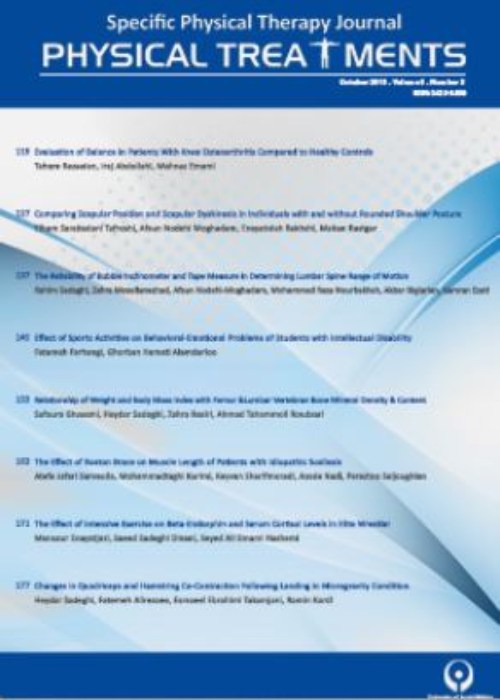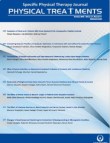فهرست مطالب

Physical Treatments Journal
Volume:12 Issue: 4, Autumn 2022
- تاریخ انتشار: 1401/12/28
- تعداد عناوین: 7
-
-
Pages 213-232Purpose
One of the most significant contributors to lower extremity degeneration alterations and its effects on balance and sports performance is dynamic knee valgus (DKV) as a faulty movement pattern. Different exercise interventions have been conducted to improve DKV. Extensive research and meta-objective analysis were conducted to assess how exercise interventions affected people with lower extremity functional indicators of DKV.
MethodsThe electronic databases Scopus, Web of Science (WoS), PubMed, Google Scholar, and Iranian databases SID and Magiran were systematically searched from inception to September 2021. Only full-text articles published in English/Persian peer-reviewed journals that met this study criterion were tracked. Two researchers evaluated the methodological quality of research findings separately, employing the Downs and Black Checklist. After collecting significant data from eligible studies, the results were integrated by applying a random-effects meta-analysis approach.
ResultsThe final systematic review and meta-analysis comprised seven of the 3470 papers deemed potentially relevant. The outcome illustrates that different exercise interventions may be effective in improving dynamic balance (SD=0.93 degrees, 95%CI: 0.54-1.32, P<0.001) and functional performance (Hedge’s g=1.695, 95% CI=1.22-2.17, Z=6.99, P<0.001) in 250 DKV participants.
ConclusionExercise interventions appear to be an effective method to enhance dynamic balance and functional performance in individuals experiencing DKV; nevertheless, these results should be regarded as preliminary due to the limited number of studies and their limitations.
Keywords: Dynamic knee valgus (DKV), Functional indices, Exercises, Meta-analysis -
Pages 233-248Purpose
Low back pain (LBP) is the most common musculoskeletal disorder reported in the community, leading to chronic pain and disability. This review aims to determine the effectiveness of prevention and management protocols on LBP in athletes.
MethodsSearches were conducted from 2010 to 2022 from international databases, including Google Scholar, Science Direct, and PubMed using keywords related to back pain in athletes. Randomized controlled trials (RCTs) presenting the prevention and management protocol for back pain of athletes were included in this review. The physiotherapy evidence database (PEDro) scale was used to check the quality of articles.
ResultsFinally, 16 articles with 1,317 subjects met the inclusion criteria. These studies have mainly focused on the effect of taping, cognitive functional approach, movement patterns, conditioning, lifestyle, motor control, segmental motion, isokinetic, core stabilization, virtual reality training, dynamic and static stretching, Mézières method, functional movement screen, and semi-customized exercises in athletes at risk of LBP. The positive effect of stability and cognitive exercises were documented.
ConclusionThe deep and superficial muscle integration exercises by correcting the body posture and correct muscle calling had the greatest effect on the balance of the muscles.
Keywords: Prevention, Management, Protocol, Low back pain, Athlete -
Pages 249-260Purpose
Sensorimotor impairment in the elderly leads to increased postural sway and plantar pressure distribution asymmetric. The plantar pressure distribution asymmetrical can cause secondary problems, such as forefoot pain, neuropathic plantar ulcers, and metatarsal stress fractures. Therefore, this study aims to examine the effect of sensorimotor training on the plantar pressure distribution symmetry in healthy elderly women.
MethodsForty healthy elderly women participated in this study and were randomly assigned to two experimental and control groups (20 people in each group). Pressure distribution was evaluated during standing with double-legs and eyes closed. The experimental group performed sensorimotor training for eight weeks, and the control group did not receive any intervention during this period. The statistical method of analysis of covariance (ANCOVA) was used to compare the results between the two groups.
ResultsAnalysis of covariance (ANCOVA) test showed that after eight weeks of sensorimotor training, the plantar pressure distribution in the forward and backward of the right (P=0.000) and left (P=0.000) foot was balanced with a high effect size. In addition, the plantar pressure distribution symmetry of the inter-limb was balanced after eight weeks of sensorimotor training with a high effect size (P=0.015).
ConclusionSensorimotor training by adjusting balance strategies and increasing the impulse sent from mechanical receptors cause sensorimotor integration and facilitates muscle activity. As a result, posture sway is reduced and plantar pressure distribution symmetrical.
Keywords: Elderly, Sensorimotor, Symmetry, Plantar pressure -
Pages 261-268Purpose
Muscle fatigue of the neuromuscular core can change the lower extremity kinematics and increase the risk of lower extremity injuries during squat movement. However, it is unclear how core muscle fatigue can change lower extremity kinematics.
MethodsSixteen female bodybuilders were included in this one-group pre-test-post-test quasi-experimental study. Subjects performed double leg squats twice before and immediately after the core muscles fatigue protocol. Kinematic variables of lower extremity motion in sagittal and frontal planes were recorded using two 21 megapixels digital video cameras with a sampling frequency of 50 Hz. The obtained data were analyzed for kinematics variables by Quinoa Motion Analysis Software. Paired sample t-test was used to compare kinematic variables before and after the fatigue protocol.
ResultsThe results of this study showed that core muscles fatigue can lead to significantly decreased knee flexion (P=0.001) and increased knee valgus angels during double leg squats movement, but no difference was observed in hip flexion and ankle dorsiflexion before and after the fatigue protocol (P=0.001).
ConclusionThe results showed that core muscle fatigue can negatively affect the alignment of the lower extremity and increase the risk of injury in female bodybuilders.
Keywords: Neuromuscular fatigue, Core stability, Female athletes, Bodybuilding -
Pages 269-278Purpose
The present study aimed to investigate the effect of six weeks of Pilates exercises on the function of the upper and lower extremities in middle-aged women with lower crossed syndrome (LCS).
MethodsThis study was a quasi-experimental research with a pre-test-post-test design. The participants included 30 females with LCS from Tiam Sport Club. They were selected using a purposive sampling method and randomly divided into Pilates exercises and control groups. The function of the upper extremity was assessed using Y and Davies tests, and the lower extremity function was assessed using side hop and square hop tests. The Pilates training program was implemented for 6 weeks, 3 days a week and each session lasted 30 minutes. Paired t-test and analysis of covariance (ANCOVA) were used to analyze data at a significance level of P≤0.05.
ResultsThe results showed that the Pilates exercise group performed better than the control group in the function tests of the upper and lower extremities (P≤0.05). No significant difference was observed between pre-test and post-test scores in the control group (P>0.05).
ConclusionBased on the results, it can be concluded that Pilates exercises can improve the function of the upper and lower extremities by enhancing the strength and efficiency of core stabilizer muscles. Therefore, it seems rational to suggest physiotherapists and coaches use these exercises in individuals with LCS.
Keywords: Pilates exercises, Lower crossed syndrome (LCS), Function, Davies test, Y test -
Pages 279-290Purpose
The current research aims to examine the effect of taping on the feedforward activity of the lower limb muscles in elite volleyball players with and without chronic ankle instability while performing single-leg jump-landing.
MethodsThe electromyographic activities of the lateral gastrocnemius, tibialis anterior, peroneus longus, rectus femoris, gluteus medius, and vastus lateralis of the non-dominant leg were registered before and after taping in 26 volleyball players while performing the spike skill with single-leg landing. These volleyball players entered the research by purposive sampling. The root mean square (RMS) was employed to compute muscle activity before and after taping. The multivariate analysis of variance (MANOVA) test at P≤0.05 was utilized to analyze the data.
ResultsThe results of the multivariate analysis of variance (MANOVA) test demonstrated that the groups did not have a significant factor in any of the variables in the feedforward phase, except for the maximum root mean square (RMS) of the peroneus longus muscle (P=0.01).
ConclusionThe results showed that taping cannot improve the feedforward activity of the selected muscles during single-leg landing in people with chronic ankle instability. Therefore, it is recommended to use other methods and exercises to improve the muscle feedforward activity in these individuals during the rehabilitation phases.
Keywords: Volleyball, Ankle injury, Muscle feedforward activity, Athletic tape, Jump-landing -
Pages 291-302Purpose
The purpose of this study is to investigate and compare the efficacy of two training programs of weight-bearing on a mini-trampoline, and ankle exercise therapy on foot-ankle functionality in people with peripheral neuropathy.
MethodsThe present research is a clinical trial study that has been conducted using two intervention groups and one control group. The statistical population of this study includes 48 women with type 2 diabetes and moderate or severe neuropathy living in Tehran. The Michigan Neuropathy Screening Instrument (MNSI) and Foot Health Status Questionnaire (FHSQ-BR) were used for collecting data. The first experimental group performed mini-trampoline exercises, while the second group performed ankle therapeutic exercises at home for eight weeks. Data were analyzed using analysis of covariance (ANOVA) and correlated t-test.
ResultsThe findings showed that mini-trampoline exercise and ankle exercise therapy had a significant effect on relieving foot pain (P<0.05), as well as improving foot functionality (P<0.05) and overall foot health (P<0.05) in both intervention groups compared to the control group. Also, the results showed that ankle exercise therapy was more effective than mini-trampoline exercise in two variables of foot pain and foot functionality (p<0.05). Both training programs showed significant effects on the ankle range of motion (p<0.05), while, there was no significant difference between the two intervention groups with respect to the range of motion of the ankle (p<0.05). Moreover, Mini-trampoline exercise and ankle exercise therapy revealed a significant effect on the range of motion of the metatarsophalangeal joints compared to the control group (P<0.05). In the range of motion of dorsiflexion of the right foot, mini-trampoline exercises were more effective than therapeutic exercises, while regarding the variable of dorsiflexion of the left foot, the effectiveness of ankle training intervention was more than that of trampoline (p<0.05). Both trampoline exercise and ankle therapeutic exercise interventions had a significant effect on ankle strength, but there was no difference in plantar flexion strength of the right foot between the two intervention groups. However, the mini-trampoline intervention was more effective than the ankle exercise therapy intervention with respect to the three variables of the hallux dorsiflexion strength of the hallux and plantar flexion strength of the left foot (p<0.05). Both training interventions were effective on the variable of right and left hallux flexion strength (p<0.05). The efficacy of none of the two interventions on the right and left hallux extension strength was confirmed; the effectiveness of both interventions on the right and left hallux flexion strength was similar with no significant difference (P>0.05). No significant difference was found in the control group after 8 weeks with respect to the relevant variables (P>0.05).
ConclusionExercises on the mini-trampoline and ankle therapeutic exercises at home can be effective in improving patients' quality of life as a simple, affordable, low-risk and quick-improvement treatment program that focuses on the use of segmental exercises for foot functionality.
Keywords: Diabetic peripheral neuropathy, Mini-trampoline, Ankle therapeutic exercise program, Plantar functionality


